Introduction:
Owning a Green Cheeked Conure is akin to inviting a burst of color and personality into your life. These vibrant parrots, also known as parakeets, have captured the hearts of bird enthusiasts worldwide. But before you bring home one of these feathered friends, it’s essential to understand their traits, care requirements, and suitability as pets. Let’s delve into the key questions potential owners often ask.
Are Green Cheeked Conures Good Pets?
Absolutely! Green Cheeked Conures make fantastic pets for the right owner. They are known for their playful and affectionate nature, forming strong bonds with their human companions. Their small size makes them suitable for apartment living, and their intelligence allows for interactive training and games.
Green Cheeked Conures absolutely love socializing and staying mentally active. It’s crucial to spend quality time with them, engaging in play and interaction. Offering a variety of toys, puzzles, and opportunities for foraging keeps their minds stimulated and boredom at bay. Regular playtime outside the cage is a must to keep them happy and thriving. After all, a stimulated Green Cheeked Conure is a happy one!
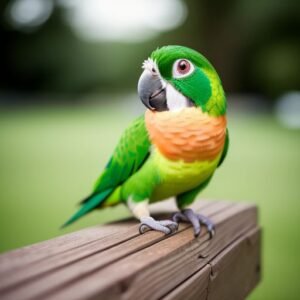
Can Green Cheeked Conures Talk?
While not as proficient as some larger parrot species, Green Cheek Conures can learn to mimic words and phrases with patience and consistent training. Their vocalizations typically include chirps, whistles, and various sounds they pick up from their environment. While not all individuals will talk, many enjoy engaging in vocal interactions with their owners.
To encourage talking, start with simple, repetitive words or phrases and reward them when they mimic correctly. Consistent training sessions and positive reinforcement will help them develop their vocal abilities over time.
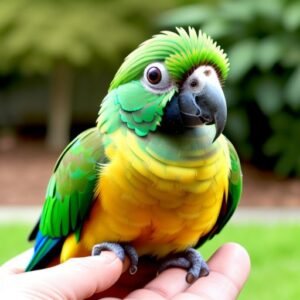
Are Green Cheeked Conures Loud?
Compared to larger parrot species, Green Cheek Conures are relatively quiet. They have a moderate noise level, which can include chirping and occasional squawking, especially during times of excitement or communication. With proper training and enrichment, their vocalizations can be manageable for most households.
It’s really important to make sure they have a peaceful and tranquil environment when it’s time for them to sleep. This helps prevent any disruptive behavior during their rest. Also, if you notice they’re making a lot of noise, it might be because they’re feeling stressed or anxious about something. By figuring out what’s bothering them and addressing it, you can help reduce their vocalizations and keep them calm and content.
Are Green Cheeked Conures Aggressive?
Green Cheek Conures are generally not aggressive birds. However, like any pet, they can exhibit territorial behavior or become nippy if they feel threatened or stressed. Early socialization, positive reinforcement training, and providing a stimulating environment can help prevent aggression and promote a well-adjusted companion.
When it comes to training Green Cheeked Conures, being consistent and patient is absolutely vital. It’s all about giving them time to learn and understand. By rewarding them when they do something right and gently guiding them away from behaviors you don’t want, you’ll help them grasp boundaries and feel secure with you as their companion. It’s a journey of trust-building and understanding between you and your feathered friend.
Feeding Behavior:
Green Cheek Conures have diverse dietary needs, consisting of a balanced diet of high-quality pellets, fresh fruits, vegetables, and occasional treats. Yes, they can indeed enjoy fruits like bananas, oranges, and grapes in moderation. These fruits provide essential vitamins and minerals, contributing to their overall health and well-being.
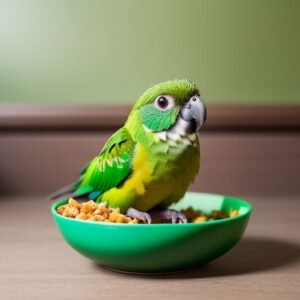
Making sure your Green Cheeked Conure gets a diverse diet is really important. Just like us, they need a mix of foods to stay healthy and happy. Keep an eye on how much they’re eating and adjust their portions as needed to keep them at a healthy weight. It’s all about keeping things interesting for them and making sure they’re getting all the nutrients they need to thrive.
Breeding Season and Growth:
what is the breeding season of green cheek conures?
In their natural habitat, Green Cheeked Conures breed during the spring and summer months. In captivity, breeding can occur year-round with proper environmental cues and conditions.
If you’re thinking about breeding Green Cheeked Conures, it’s essential to be well-prepared. Think of it like welcoming new additions to your family! Make sure you have all the necessary knowledge and resources to provide proper care for the babies. Responsible breeding means ensuring the health and well-being of both the parents and the offspring.
At what age Green cheek conures reach maturity?
They reach maturity between one to two years of age, with their full-grown size typically attained within the first year.
Pros and Cons:
Pros:
- Affectionate and playful companions.
- Small size suitable for apartment living.
- Intelligence allows for interactive training.
- Moderate noise level compared to larger parrot species.
- Vibrant colors and engaging personalities.
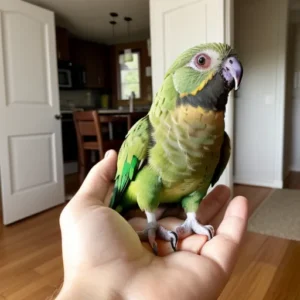
Cons:
- Requires socialization and mental stimulation.
- Can be prone to behavioral issues if not properly trained.
- Regular cage cleaning and maintenance are necessary.
- Potential for noise, especially during times of excitement or communication.
- Long lifespan requiring a commitment to long-term care.
Conclusion:
In conclusion, Green Cheeked Conures are delightful companions for who invest time, patience, and love into their care. Their playful antics, colorful plumage, and affectionate nature make them a joy to have in any household. By understanding their needs and behaviors, providing proper care and enrichment, you can cultivate a fulfilling and enriching relationship with your feathered friend. So, if you’re ready to welcome a burst of energy and vibrancy into your life, consider adding a Green Cheeked Conure to your family!
FAQs:
Where are Green Cheeked Conures from?
Green Cheeked Conures are native to South America, specifically found in regions such as Brazil, Bolivia, Argentina, and Paraguay. Their natural habitat includes forests, woodlands, and savannas.
What is the lifespan of Green Cheek Conures?
On average, Green Cheeked Conures have a lifespan of 15 to 30 years when provided with proper care, diet, and living conditions. With attentive care, some individuals may even exceed these expectations.
Why do Green Cheek Conures bob their head?
Head-bobbing is a common behavior in Green Cheeked Conures and other parrot species. It's often a sign of excitement, curiosity, or communication. They may also bob their heads while listening to music or when feeling particularly playful.
Why are Green Cheeked Conures expensive?
Green Cheeked Conures can be relatively expensive due to factors such as their popularity as pets, the time and resources invested by breeders in hand-raising and socializing them, and the cost of quality care, including veterinary expenses. Additionally, factors like color mutations and breeder reputation can also influence their price.
Is a Green Cheek Conures parrot bite painful?
While Green Cheeked Conures have small beaks compared to larger parrot species, their bites can still cause discomfort, especially if they bite hard or repeatedly. However, with proper training and socialization, biting incidents can be minimized, and they typically pose no serious harm.
Can a Green Cheek Conures parrot eat pineapple?
Yes, Green Cheeked Conures can enjoy pineapple as part of their varied diet. Pineapple is a nutritious fruit rich in vitamins and minerals, providing essential nutrients to support their overall health. However, it should be offered in moderation alongside other fruits and vegetables to ensure a balanced diet.
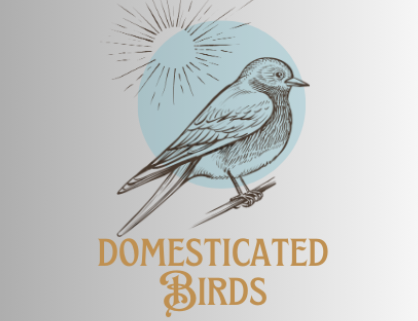
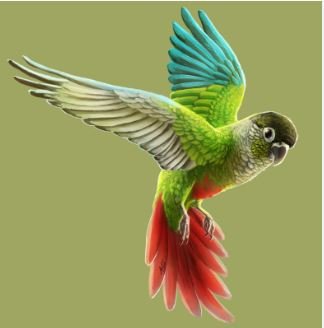
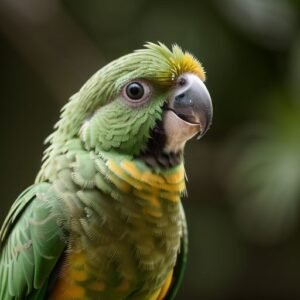
2 thoughts on “Green Cheeked Conures as pet: 5 things You Need to Know with Q&A.”